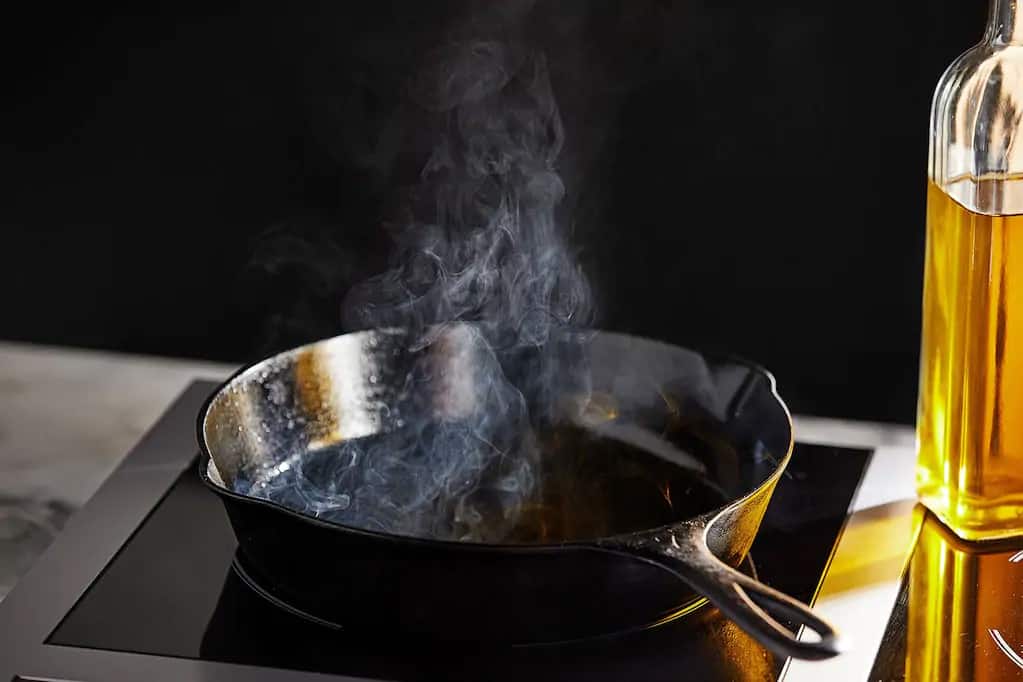Knowing the smoke point temperatures of cooking oils and fats is important. This informational guide lists when common oils begin to break down and degrade. Making the right selection will help optimize nutrition, taste, and safety in the kitchen.
Cooking oils are essential for deep frying and preventing food from sticking to pans. However, they all have limitations based on their composition. Do you know how to choose oil for different cooking applications and why? Using the smoke point is one of the most objective ways to make a selection, keeping function, health, and safety in mind.
For example, when cooking at high temperatures like stir-frying or deep frying, selecting an oil with a high smoke point is best to provide a comfortable buffer during the cooking process. You’ll also want to consider the duration, as a quick saute can use butter with a lower smoke point, but only because the time in the pan is not as long as pan-frying something like breaded chicken.
The best temperature to deep fry is between 350-375°F, so the best frying oils will have a smoke point that’s higher than 375 so that they will be less likely to smoke the longer they’re in use. Read below to lean the perfect frying oil temp for common oils so you can get it right every time.

How composition affects smoke point
The structure of oils, especially free fatty acids, determines their suitability for high-temperature frying. By definition, fats are solid at room temperature, while oils remain liquid. Fats are made up of triglycerides, which are three fatty acids bonded to a glycerol molecule.
Most meat-based fats, such as butter, are high in saturated fats, while plant-based oils are high in unsaturated fats. The health benefits are better when cooking with plant-based oils. However, the taste of animal fats is more flavorful.
What does smoke point mean?
The smoke point temperature is when oil breaks down into free fatty acids and visibly produces smoke. This temperature, measured with a thermometer, varies between different oils, and all oils will smoke with prolonged heating. Maintaining this temperature can become unsafe and possibly start a fire if you reach the flashpoint of the oil.
| FAT / OIL | SMOKE POINT | APPLICATION |
|---|---|---|
| Butter | 300-350°F (149-175°C) | Saute, quick pan-fry, baking, roasting |
| Extra-Virgin Olive Oil | 325-410°F (163-210°C) | Saute, finishing oil, dressings, marinades, baking |
| Coconut Oil | 350-385°F (175-196°C) | Saute, pan-fry, baking, roasting |
| Sesame Oil | 350-410°F (175-210°C) | Saute, small amount for stir-frying |
| Vegetable Shortening | 360-410°F (180-210°C) | Baking, saute |
| Lard | 370°F (188°C) | Saute, pan-fry, baking, roasting, deep-frying |
| Grapeseed Oil | 390°F (195°C) | Saute, pan-fry, baking, roasting, dressings |
| Canola Oil | 400-450°F (204-230°C) | Searing, saute, pan-fry, stir-fry, baking, roasting, grilling, deep-frying |
| Vegetable Oil | 400-450°F (204-230°C) | Searing, saute, pan-fry, stir-fry, baking, roasting, grilling, deep-frying |
| Margarine | 410-430°F (210-221°C) | Saute, stir-fry, roasting |
| Corn Oil | 410-450°F (210-230°C) | Searing, saute, pan-fry, baking, roasting, grilling, deep-frying |
| Light/Refined Olive Oil | 425-465°F (218-241°C) | Saute, pan-fry, grilling, baking, roasting |
| Sunflower Oil | 440°F (230°C) | Searing, saute, pan-fry, baking, roasting, grilling, deep-frying |
| Peanut Oil | 440-450°F (227-230°C) | Searing, saute, pan-fry, stir-fry, baking, roasting, grilling, deep-frying |
| Clarified Butter | 450°F (230°C) | Saute, pan-fry, baking, roasting |
| Soybean Oil | 450-495°F (230-257°C) | Searing, saute, pan-fry, baking, roasting, grilling, deep-frying |
| Safflower | 510°F (265°C) | Searing, saute, pan-fry, baking, roasting, grilling, deep-frying |
| Avocado Oil, Refined | 520-570°F (271-299°C) | Saute, pan-fry, baking, roasting, grilling, dressings |
HOW TO TELL WHEN OIL IS HOT ENOUGH WITHOUT A THEMOMETER
FAQ
How do you heat oil to 350?
At what temperature does oil burn?
What is the best oil temperature?
How do you heat oil to 375 on the stove?
Does frying oil need to be Hot Hot?
Yes, it is done at high temperatures, and the oil needs to be hot hot hot, but not too hot. Some people tend to believe that the higher the temperature, the better the frying process. But this is not actually true; too high a temperature will make the frying oil degrade much. Also, food will burn on the outside before cooking on the inside.
What temperature should deep frying oil be?
Most deep frying starts with oil between 325 and 375 degrees, but the temperature drops when food is added. Once the oil recovers some heat, it should remain somewhere between 250 and 325 degrees (depending on your recipe) for the duration of cooking. To maintain the proper oil temperature, use a clip-on deep-fry thermometer and keep close watch.
What happens if oil is too hot?
If the oil is too hot, the food will burn on the outside before cooking on the inside. But the more common problem with oil temperature is that it’s too low, and that causes the food to start absorbing the oil. So, if you’ve eaten fried food that tasted overly greasy, chances are it was fried at too low a temperature.
How do I know if my cooking oil is hot?
The best way to know the temperature of your cooking oil is to use a long-stem fry thermometer ( like this one ). Place it in the pan, turn the heat to medium-high, and wait until the temperature reaches the desired setting according to the chart below. Then, turn the heat down to medium and add your food. Easy, peasy!
